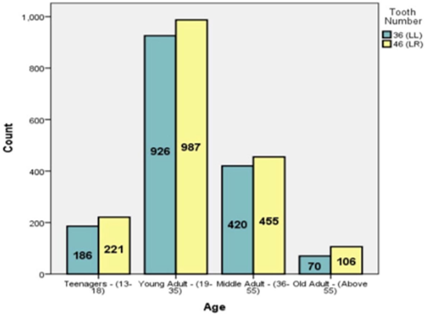Abstract
The mandibular first molars are one of the first permanent teeth to erupt; thus, it remains the longest in terms of exposure to cariogenic pathogens. Also, its anatomical location and structure make it a prime location for dental caries (DC) but hard to access for cleaning. Thus, we aim to compare its incidence in adults and teenagers because the identification of the most susceptible age for tooth decay is key in prevention and prophylaxis against the same. A retrospective cross-sectional study was conducted by reviewing and analysing the data of 86,000 patient records from June 2019 to April 2020. Patients with treated mandibular first molars were selected from the age group of 13 and above. A Microsoft Excel 2016 data spreadsheet was used to collect data and was later exported to the Statistical Package for the Social Sciences for Windows (Version 20.0, SPSS). The number of males with DC in their mandibular first molar (59%) was higher than that of the females (41%). The highest number of cases were reported to prevail in the 'Young Adults' group, with 56.7%, followed by the 'Middle Adults' with 26%. This shows that adults have a higher incidence of DC in their mandibular first molars than teenagers. Also, there was a clear incidence of 46 having a higher incidence than caries in 36. (52.5% > 47.5%). There is an association between age and incidence of dental DC as proved by our Chi-Square Test, where we obtained a 'p' value of p<0.05, making it statistically significant. Once lost, our teeth cannot be naturally replaced, making prevention imperative. Thus, identifying the age in which we are most prone to decay is a great leap forward. But since the study does present with limitations, further research needs to be done to confirm the same.
Full text article
Authors

This work is licensed under a Creative Commons Attribution-NonCommercial-NoDerivatives 4.0 International License.

